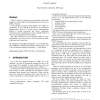Free Online Productivity Tools
i2Speak
i2Symbol
i2OCR
iTex2Img
iWeb2Print
iWeb2Shot
i2Type
iPdf2Split
iPdf2Merge
i2Bopomofo
i2Arabic
i2Style
i2Image
i2PDF
iLatex2Rtf
Sci2ools
123
Voted
VRML
1998
ACM
1998
ACM
Event Processing for Complicated Routes in VRML 2.0
VRML 2.0 allows a content creator to dynamically control state changes in a virtual reality world by defining routes of events over VRML 2.0 nodes. In the conceptual execution model defined in the VRML 2.0 specification, an event should be delivered to its destinations instantaneously. However it makes browser implementation difficult in routing connections that involve complicated requirements such as simultaneous events in multiple fields of a node, or cyclic dependencies between nodes. This paper describes an event processing method we have implemented in our VRML browser, which is designed to handle complicated route connections. CR Categories and Subject Descriptors: I.3.6 [ Methodology and Techniques ] Graphics data structures and data types; I.3.7 [ Three-Dimensional Graphics and Realism ] Virtual Reality.
| Added | 05 Aug 2010 |
| Updated | 05 Aug 2010 |
| Type | Conference |
| Year | 1998 |
| Where | VRML |
| Authors | Masaaki Taniguchi |
Comments (0)

